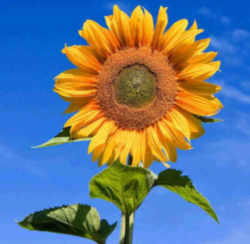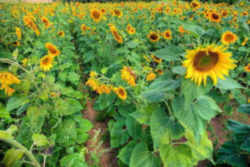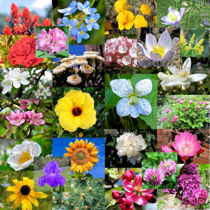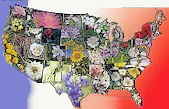Kansas State Flower & Floral Emblem
Helianthus or Wild Native Sunflower

(Helianthus annuus)
Adopted in 1903.
The Kansas state flower and floral emblem is the the wild native sunflower, (Helianthus annuus,) also know as Common Sunflower, Wild Sunflower and Annual Sunflower was adopted in 1903.
IThere are about fifty two different varieties of sunflowers that are native to North America and wild sunflowers are common in all parts of Kansas so much so that people had recognized Kansas as the Sunflower State before they adopted wild native sunflower as the the state flower and floral emblem in 1903 (the sunflower is also is featured on the Kansas state quarter, Kansas state flag, and the nickname for Kansas is ("The Sunflower State)."
There are eleven species of sunflower recorded from Kansas. Most of them are perennials.
Kansas State Flower: Wild Native Sunflower

In September the fields and roadsides of the Great Plains erupt in a blaze of yellow as the sunflowers and goldenrods (also members of the sunflower family) make their presence known to the local pollinating insects. While many sunflower species may begin blooming in July, they are not as noticeable then as later on when they have grown up and over the surrounding vegetation. There are eleven species of sunflower recorded from Kansas. Most of them are perennials. Only the common sunflower and H. petiolaris, the Prairie Sunflower, are annuals. Identification of sunflowers can be very complicated because they frequently hybridize and even within species there is a high degree of variability. With a little practice, however, the most common species can be readily recognized.
History of the Sunflower with People
The Common Sunflower has a long history of association with people. Nearly 3,000 years ago it was domesticated for food production by the Native Americans. The seeds of the wild type of sunflower are only about 5 mm. long. It was only through careful selection for the largest size seeds over hundreds of years that the cultivated sunflower was produced. Lewis and Clark made mention in their journals of its usage by the plains Indians. It was brought back to the Old World by the early European explorers and widely cultivated there also. Today it is a common alternative crop in the Great Plains and elsewhere for food and oil production. Next time you munch down on some sunflower seeds, thank the many generations of Native Americans whose careful husbandry gave us this valuable food item.
Characteristics of the Sunflower
The wild cousins of those grown on the farm are still common, however, in fields, roadsides and disturbed ground throughout the Great Plains.
The Common Sunflower is a typical member of the Asteraceae, one of the largest and most successful families of plants. Within the structure we think
of as the "flower", it actually has two different types of flowers - ray and disk flowers.
The ray flowers have the big, strap-like structures that we see around the edge of the "flower" while the disk flowers occupy the middle of it. Within
the Asteraceae, many confusing combinations of the two are possible along with the total absence of one or the other in some species! Individual ray
or disk flowers may be male, female or both and either fertile or infertile (do or don't produce seeds). In sunflowers, the ray flowers are usually
female and infertile. The disk flowers are both male and female and are fertile.
If you look closely at the center of a sunflower you can see that the disk flowers grow in a mesmerizing pattern of two opposite spirals. This is most
easily seen either before the disk flowers open up or after the seed has set and all the accessory flower parts have fallen off. This is one of the
more interesting patterns in nature.
The rough-hairy quality of the Common Sunflower is characteristic of many members of its family. These little bristles probably serve two functions:
to discourage plant-eating animals and to conserve water in the plant by limiting evaporation.
Members of the sunflower family are popular with butterflies because the wide flower head makes a good "landing platform" and the numerous individual
flowers make for a high probability of finding nectar. Monarch butterflies are commonly seen getting nectar from sunflowers during their fall migration.
Whether as a source of food for people and wildlife or an eye-catching splash of color on the landscape, the Common Sunflower is an important member
of the prairie community.
Identification of the Sunflower
- Flowering Season: Summer
- Light Requirements: Sun
- Flower Color: Gold, red-brown, yellow
- Height: 12 to 108 inches
- Spacing: 12 to 24 inches
- Comments: Moderate to high drought tolerance
- Cultivars: Full Sun Single
The Kansas Statutes
The law designating the wild native sunflower as the official Kansas state flower and floral emblem is found in the Kansas Statutes, Chapter 73, Article 18, Section 73-1801.
Chapter 73.--SOLDIERS, SAILORS AND PATRIOTIC EMBLEMS.
Article 18.--STATE FLOWER AND FLORAL EMBLEM.
SECTION 73-1801.
73-1801. State flower and floral emblem.
WHEREAS, Kansas has a native wild flower common throughout her borders, hardy and conspicuous, of definite, unvarying and striking shape, easily sketched,
moulded, and carved, having armorial capacities, ideally adapted for artistic reproduction, with its strong, distinct disk and its golden circle of
clear glowing rays - a flower that a child can draw on a slate, a woman can work in silk, or a man can carve on stone or fashion in clay; and
WHEREAS, This flower has to all Kansans a historic symbolism which speaks of frontier days, winding trails, pathless prairies, and is full of the life
and glory of the past, the pride of the present, and richly emblematic of the majesty of a golden future, and is a flower which has given Kansas the
world-wide name, "the sunflower state": therefore,
Be it enacted by the Legislature of the State of Kansas: That the helianthus or wild native sunflower is hereby made, designated and declared to be
the state flower and floral emblem of the state of Kansas.
History: L. 1903, ch. 479, § 1; June 1; R.S. 1923, 75-3033.
Taxonomic Hierarchy: Wild Native Sunflower
Kingdom: Plantae - Plants
Subkingdom: Tracheobionta - Vascular plants
Superdivision: Spermatophyta - Seed plants
Division: Magnoliophyta - Flowering plants
Class: Magnoliopsida - Dicotyledons
Subclass: Asteridae
Order: Asterales
Family: Asteraceae - Aster family
Genus: Helianthus L. - sunflower
Species: Helianthus annuus L. - common sunflower
State Floral Emblems








